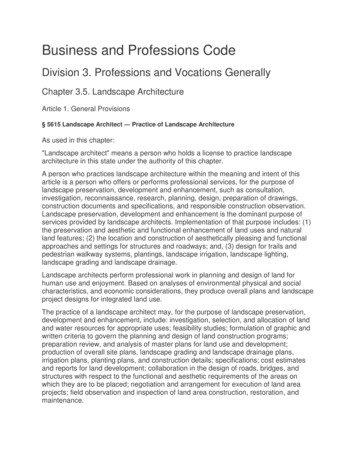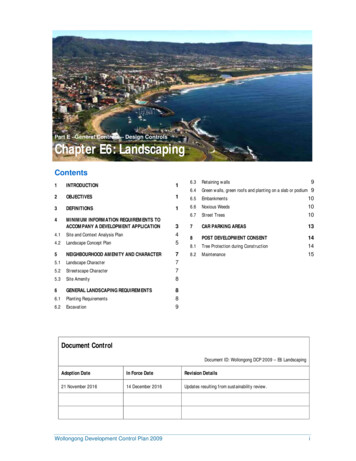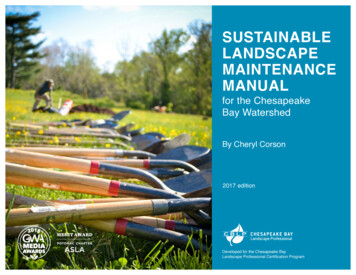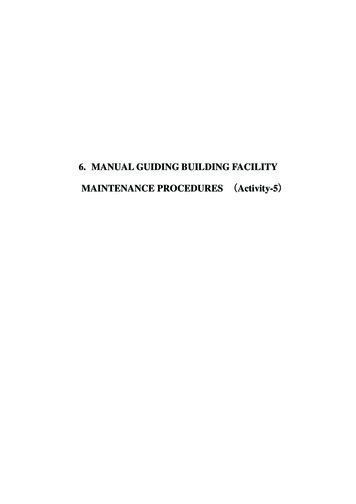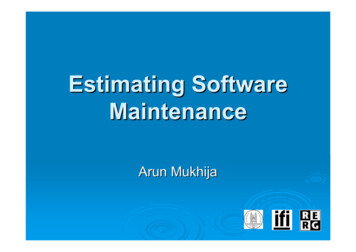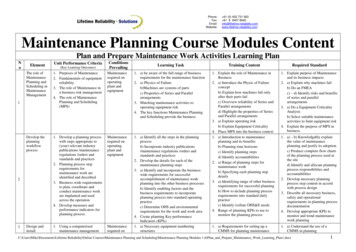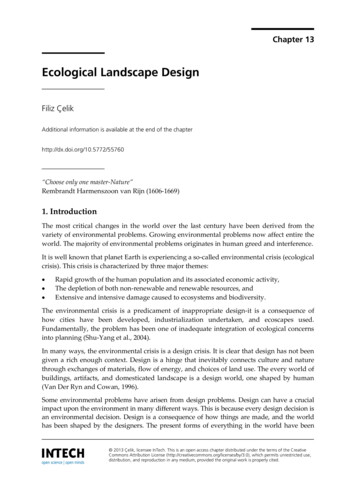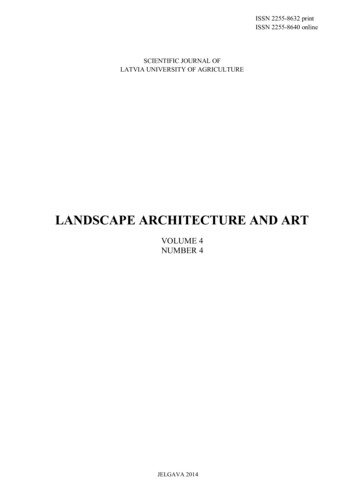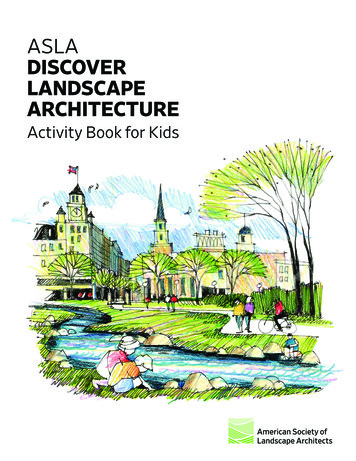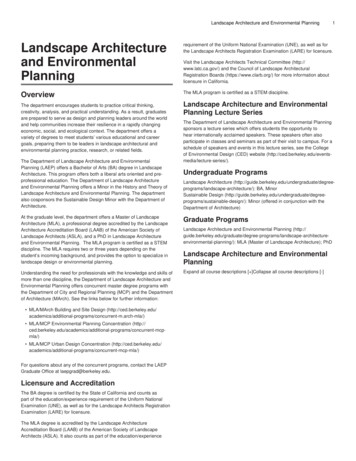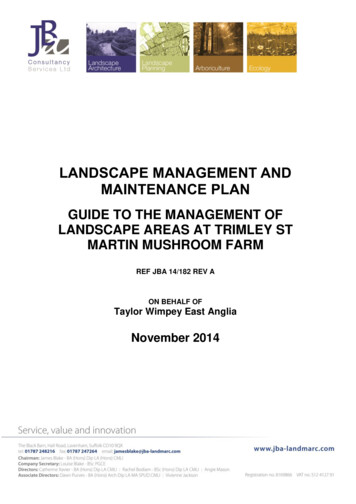
Transcription
LANDSCAPE MANAGEMENT ANDMAINTENANCE PLANGUIDE TO THE MANAGEMENT OFLANDSCAPE AREAS AT TRIMLEY STMARTIN MUSHROOM FARMREF JBA 14/182 REV AON BEHALF OFTaylor Wimpey East AngliaNovember 2014
Landscape Management & Maintenance Plan:Prepared by: JBA Consultancy Services Ltd.ContentsPage1.0INTRODUCTION31.1Purpose and Scope of Document31.2The Grounds31.3Recitals52.0AIMS AND OBJECTIVES OF THE LANDSCAPE MANAGEMENT PLAN62.1Aims62.2Objectives73.0SPECIFIC ELEMENTS REQUIRING MANAGEMENT AND MAINTENANCE73.1Landscape Areas and Landscape Components73.2Existing/Mature Trees83.3Existing Hedgerows93.4New Tree Planting103.5Ornamental Hedgerows123.6Ornamental Shrubs and Groundcover Planting143.7Native Whip, Shrub and Buffer Planting163.8Amenity Grass / Lawns with bulbs183.9Wildflower Grassland203.10Hard Landscape Areas223.11Structures, Walls, Fences, Railings and Gates233.12Street Furniture244.0IMPLEMENTATION, MONITORING AND REVIEW254.1Implementation254.2Process for Monitoring and Review255.0APPENDICES275.1Management Areas Plan275.2Schedule of Maintenance Operations285.3Pruning Schedule for Native Plants332Client: Taylor Wimpey East AngliaDate: November 2014Site Name: Trimley St Martin Mushroom Farm
Landscape Management & Maintenance Plan:Prepared by: JBA Consultancy Services Ltd.1.0INTRODUCTION1.1PURPOSE AND SCOPE OF DOCUMENT1.1.1 The Management Plan shall be taken to include this document and anysupporting plans, reports and specifications approved as part of the planningapplication for the residential redevelopment of land at Trimley St MartinMushroom Farm. This includes any documentation containing quantitative andqualitative information about the external areas of the site that will be useful tothose responsible for managing and maintaining them.1.1.2 The purpose of this document is to schedule all required maintenance regimes,operations and works necessary for the satisfactory management of thelandscape in perpetuity. The Management Plan sets out the management aimsand objectives for the site along with the specific management objectives foreach landscape component, and the associated maintenance works requiredon an Annual and Occasional basis. The Annual Works are those works thatwill be required every year, such as watering, weeding and cleaning. TheOccasional Works are those that will be required on an irregular or cyclicalbasis, such as repairs and renewals.1.2THE GROUNDS1.2.1LocationThe site is situated on the south-west side of High Road in Trimley St Martin,and centres at approximate grid reference TM 273 373 to the south-west of theA14. To the north and north east are the residential areas of Trimly St Martin.To the south and west the site borders arable farmland. (See Figures 1 and 2below).1.2.2Site Description and Development ProposalsThe proposals for the site consist of residential development, together withparking areas, an area of public open space and landscaping. Vehicular accessis from the roundabout on High Road to the east. The boundaries of the siteare defined by existing mature hedgerows and trees to the south and southwest. An existing large residential building with associated large garden bordersthe northern boundary and includes some mature boundary trees which willremain. All other vegetation is to be removed and replaced as part of acomprehensive detailed landscape scheme (refer to drawing JBA 14/182-01).1.2.3 An ecological baseline site audit was undertaken in July 2012 prior todevelopment. No evidence of roosting bats, badgers, great crested newts,reptiles, water voles, otters or other protected species were found on site.3Client: Taylor Wimpey East AngliaDate: November 2014Site Name: Trimley St Martin Mushroom Farm
Landscape Management & Maintenance Plan:Prepared by: JBA Consultancy Services Ltd.Fig 1. Location plan: Road Map: Not to scaleThe site is locatedapproximately here.Fig 2. Location plan: Site Boundary: Not to scale4Client: Taylor Wimpey East AngliaDate: November 2014Site Name: Trimley St Martin Mushroom Farm
Landscape Management & Maintenance Plan:Prepared by: JBA Consultancy Services Ltd.1.2.6 Management Plan AreasThe purpose of this management plan document is to ensure the appropriatemanagement of the retained and proposed landscape areas on the sitefollowing the construction and completion of the development. The landscapeareas include existing boundary vegetation along with all new planting (trees,hedges, shrubs and grass) and other hard or soft landscape components.1.2.7 All of the landscape and ecological areas of the site, except for private gardens,will be the subject of the Landscape Management Plan. The landscape areassubject to this Management Plan are set out in Appendix 5.1.1.3RECITALS1.3.1Parties Involved1.3.2 The Developer: Taylor Wimpey East Anglia is responsible for theconstruction of this development. The developer will be responsible forthe protection and management of existing landscape componentsthrough the construction phase and the implementation of the hard andsoft landscape works in accordance with the planning drawings, includingany contractual maintenance period associated with these works. The Local Planning Authority: This term (abbreviated to LPA) shall referto Suffolk Costal District Council and its Planning and Landscape Officerswho are involved in the process of the approval of landscape and otherdocumentation. The Adopting Organisation: This is the organisation that will adoptownership of the landscape areas and is therefore responsible for theirmanagement and maintenance including all landscape components andfeatures within them. The Adopting Organisation for the site will be aPrivate Management Company to be appointed by the Developer. TheAdopting Organisation shall also be taken to mean any employee orrepresentative of the organisation in ownership of the grounds. The Landscape Management Contractor: the company who may beappointed by the Adopting Organisation to carry out the landscapemaintenance works.Status of the Landscape Management PlanPrior to the commencement of development (or such other date or stage indevelopment as may be agreed in writing with the LPA) a detailed long termLandscape Management and Maintenance Plan for all landscape areas shall besubmitted to and approved by the LPA in writing. The plan shall include: Aims and Objectives; A description of Landscape Components; Management Prescriptions; Details of maintenance operations and their timing; and5Client: Taylor Wimpey East AngliaDate: November 2014Site Name: Trimley St Martin Mushroom Farm
Landscape Management & Maintenance Plan:Prepared by: JBA Consultancy Services Ltd. Details of the parties/organisations who will be maintain and manage thesite, to include a plan delineating the areas that they will be responsiblefor.The plan shall demonstrate full integration of landscape, biodiversity andarboricultural considerations. The areas of planting shall thereafter be retainedand maintained in perpetuity in accordance with the approved LandscapeManagement and Maintenance Plan, unless any variation is approved in writingby the Local Planning Authority.1.3.3 The LPA will approve this document as part of the planning process and thisdocument therefore forms part of the approved planning documents.Management shall therefore be carried out in accordance with this documentfollowing completion of the implementation management plan (and anycontractual maintenance periods associated with these works). This documentwill outline the minimum standard of maintenance to ensure a safe,comfortable, attractive, biodiverse and sustainable landscape is achieved inperpetuity.1.3.4 Supportive InformationThis Management Plan is submitted together with the Landscape Masterplan(drawing number JBA 14/182-01).1.3.5 The document should be read in conjunction with the following planningdocuments: Landscape and Visual Impact Assessment, Land at Mushroom farm,Trimley St Martin, LSDP, December 2012; Character Study and Design Approach, Trimley St Martin , Taylor Wimpeyeast Anglia, May 2014; Arboricultural report: Land adjacent to Mushroom Farm, Trimley St Martin,LSDP, February 2013; and The Mushroom farm, Trimley St Martin: A Biodiversity and EuropeanProtected Species Survey, Aurum Ecology, July 2012.2.0AIMS AND OBJECTIVESMANAGEMENT PLAN2.1AIMSOFTHELANDSCAPE2.1.1 The principal aims of this Landscape Management Plan are to secure acoordinated and high standard of landscape management for the landscapeareas within the site, to ensure the successful integration of the residentialdevelopment with the surrounding landscape and to protect and enhancenature conservation interests in accordance with the design objectives in theapproved planning documents. This will include the appropriate maintenanceof existing retained, and proposed landscape components.6Client: Taylor Wimpey East AngliaDate: November 2014Site Name: Trimley St Martin Mushroom Farm
Landscape Management & Maintenance Plan:2.2Prepared by: JBA Consultancy Services Ltd.OBJECTIVES2.2.1 The main objectives of the Landscape Management Plan are as follows: To maintain landscape character: To protect and conserve the existinglandscape character and screening function of the existing trees andhedgerows, and to incorporate locally indigenous species withinscreening/structural landscape areas, to provide an attractive and robustlandscape setting for the buildings on the site and reinforce localdistinctiveness; The sustainable management of existing vegetation: To retainexisting trees, hedgerows and other vegetation that are worthy ofretention, and to enhance their character, composition and age structurethrough positive management with consideration to long-term viability andhealth and safety; To achieve a high standard of maintenance: To take measures toensure the successful establishment and growth of new structural andincidental planting and to take appropriate long-term managementmeasures to ensure the satisfactory appearance and sustainability ofvegetation. To ensure that landscape components are replaced,augmented and/or improved over time as appropriate; To maintain and enhance biodiversity: To protect and enhance thenature conservation interest of both existing and new habitats and toensure the adoption of management practices that enhance thebiodiversity value of the site. To fulfil all legal requirements in relation tothe protection and management of ecological features and the protectionand management of target species including bats and reptiles; To ensure health and safety: To uphold the duty of care that alllandscape components are safe and that all reasonable steps are takento minimise risk of injury and damage to people and property; and To provide a mechanism or monitoring and review: To ensure thatmanagement practices are monitored and where necessary reviewed onan annual basis in accordance with changing site circumstances and theviews of key stakeholders (Adopting Authority, residents representativesand MENTAND3.1LANDSCAPE AREAS AND LANDSCAPE COMPONENTS3.1.1 The landscape areas subject to this Landscape Management Plan include thefollowing components: Existing trees; Existing hedgerows Proposed new tree planting; Proposed native hedgerow planting Proposed ornamental hedgerows;7Client: Taylor Wimpey East AngliaDate: November 2014Site Name: Trimley St Martin Mushroom Farm
Landscape Management & Maintenance Plan: Prepared by: JBA Consultancy Services Ltd.Proposed ornamental shrubs;Proposed amenity grass/lawns;Proposed wildflower areas;Proposed bulb planting;Proposed structures, walls, railings, fencing and gates; andHard landscape areas3.1.2 The information includes a description and specific management objectives foreach component along with the annual and occasional management regimesrequired.3.1.3 The extent and location of the different landscape components is shown on theLandscape Management Areas Plan in Appendix 5.1.3.23.2.1EXISTING / MATURE TREESDescription The majority of existing trees on the western, southern and easternboundary of the site will be retained as part of the landscape strategy forthe development. The existing trees on and adjacent to the site are set out in theArboricultural Report. A Tree Survey Schedule and Tree Protection Plan(TPP) will identify the location, species, size and condition of the existingtrees to be retained by the proposed development and identify any initialworks to be completed by the Developer during the construction phase aswell as any on going monitoring which may be required.3.2.2Management ObjectivesThe management objectives for retained trees are to: Maintain the trees in as healthy and attractive condition for as long aspossible, to ensure continuity in tree cover and their contribution to thelandscape structure, biodiversity, and screening/amenity value of the site;and Ensure that trees are healthy and safe, particularly in places in proximityto residential properties and with public access.3.2.3 Annual Worksi) Visual Inspection: Trees should be regularly visually checked for thepresence of any diseased or rotten wood; fungal or otherinfections/disease; and stability. If any such issues are identified then theadvice of a qualified arboriculturist should be sought immediately.ii) Annual Arboricultural Assessment: In any event, an ArboriculturalAssessment should be undertaken once annually by a qualifiedarboriculturist inspecting the condition of existing trees including any causeof increased risk to people or property.Furthermore during theArboricultural Assessment, the health of the trees shall be monitored andany works required for health and safety or to promote the health andsustainability of existing trees shall be identified, scheduled and actioned at8Client: Taylor Wimpey East AngliaDate: November 2014Site Name: Trimley St Martin Mushroom Farm
Landscape Management & Maintenance Plan:Prepared by: JBA Consultancy Services Ltd.a suitable time of year following application and granting of appropriateconsents by the LPA (where required), refer to Occasional Works inparagraph 3.2.4 below.3.3EXISTING HEDGEROWS3.3.1 Description Existing hedgerows are present at the eastern and southern boundariesof the site and will be retained as a key component of the landscape andbiodiversity strategy, providing screening and an ecological corridoraround the proposed development. The hedgerows include elm and hawthorn. Prior to development, none ofthe hedgerows on the site were deemed “important” in the context of thelandscape and wildlife criteria of the Hedgerow Regulations, 1997. The existing vegetation on and adjacent to the site is set out in theArboricultural Report. The Tree Survey Schedule and Tree ProtectionPlan (TPP) identify the location, species, size and condition of the existingvegetation to be retained by the proposed development and identify anyinitial works to be completed by the Developer during the constructionphase as well as any on going monitoring which may be required. Thisincludes the reduction of the hedgerow to an approximate height of 3mand a formal shape as advised by the Arboricultural Report to aide futuremanagement.3.3.2 Management ObjectivesThe management objectives for the existing hedgerow are to: To maintain and enhance where appropriate the screening value,augmenting any hedgerow gaps; and To traditionally manage the hedgerow to develop its structure and todevelop its wildlife value, particularly for birds and bats.3.3.3 Annual Worksi) Annual Cutting of Native Hedgerows: To maintain a natural profile, handtrim or cut the top and sides of native hedges once annually in lateNovember (outside of the bird nesting season once leaves have started todrop), to an approximate height of 3m to form an even and tidy hedge line,retaining individual hedgerow trees. Cut larger stems, and prune anydiseased rotten wood back to sound wood. Remove all cut material fromsite.ii) Hedgerow Ground Flora: Leave the vegetation beneath the hedge lineuncut to allow ground flora to develop. Avoid the use of herbicides andpesticides in the vicinity of native hedgerows.iii) Annual Arboricultural Assessment: An Arboricultural Assessmentshould be undertaken once annually by a qualified arboriculturist to inspectthe condition of existing vegetation. The health of existing hedgerows shallbe monitored and any works required for health and safety or to promotethe health and sustainability of existing hedgerows shall be identified,9Client: Taylor Wimpey East AngliaDate: November 2014Site Name: Trimley St Martin Mushroom Farm
Landscape Management & Maintenance Plan:Prepared by: JBA Consultancy Services Ltd.scheduled and actioned at a suitable time of year, refer to OccasionalWorks in paragraph 3.3.4 below.3.3.4Occasional Worksi) Occasional Works to Native Hedgerows: Where identified by the annualArboricultural Assessment e.g. where native hedgerows have becomeovergrown or require more extensive work, carry out recommendedremedial work, including coppicing or hedge laying (in sections) to thickenand rejuvenate the hedge line. All extensive works shall be carried out bya skilled, qualified and approved Arboricultural Contractor in accordancewith BS3998: 2010 'Tree Work - Recommendations'. All arisings that resultfrom such management works shall be removed off site, unless needed toenlarge or renew hibernacula or eco piles.ii) Timeframes & Specialist Advice: All works should be completed at anappropriate time of year and in accordance with relevant EU and UKwildlife legislation. Where possible this should be outside of the birdnesting season (i.e. between October through to March inclusive). In anyevent according to the nature of the works, there may be an additionalrequirement for monitoring or a watching brief by a qualified ecologist toensure there are no nesting birds or bats present.iii) Gapping up native hedges: Where sections of hedgerow become thin orfail, gap up hedgerows with an appropriate mix of native species to anapproximate density of 6 plants/linear metre, planted in a double staggeredrow during the planting season (November through to mid-Marchinclusively). Plants should be a minimum size of open ground whips 600900mm high or 3L container grown stock for evergreen species (such asholly). Gap up areas of less dense growth with additional plants asrequired to achieve a continuous hedge line taking due allowance fornatural growth and regeneration of cut material. All plants should be native(from a source of local provenance where possible), appropriate to thecharacter of the area and should be selected to increase the speciesdiversity of the existing hedgerow and maximise ecological value.3.4PROPOSED NEW TREE PLANTING3.4.1 Description New tree planting is incorporated into the proposed development alongstreets, within POS and within gardens and parking areas to providelandscape structure and amenity value. Such tree planting will definefocal points, enclose streets and spaces and soften the built form.3.4.2 Management ObjectivesThe management objectives for new tree planting is to: Ensure the satisfactory establishment and growth of new tree plantingtypical of the respective species; Promote conditions so that trees are healthy and safe; and Ensure continuity of the design approach and amenity value of treeplanting.10Client: Taylor Wimpey East AngliaDate: November 2014Site Name: Trimley St Martin Mushroom Farm
Landscape Management & Maintenance Plan:Prepared by: JBA Consultancy Services Ltd.3.4.3 Annual Worksi) General tree maintenance during establishment: Check all trees forfirmness and stability in the ground. Check and adjust tree ties, replacing ifnecessary. Top up bark mulch levels where necessary around the base ofnew trees, using the same or similar product to that previously supplied tomaintain an approximate depth of 50mm to reduce competition from weedsand retain soil moisture. Where trees are in grass areas, remove weedgrowth by hand and retain a circle of bark mulch (approximate radius of500mm) to aid mowing and prevent damage to the main stem. All treesshall be fertilised using a suitable and approved liquid feed (N10:P15:K10)at a rate of 60g/m² during early May and again in late September. Pruneback any diseased or rotten wood (including the removal of main stemsand limbs) back to sound wood as required. Remove all cut material fromsite.ii) Watering trees: Water trees during dry periods (being any period withoutsubstantial rainfall for 14 days or more), until trees are successfullyestablished. Water at a rate of 25 litres per tree position into wateringtubes. Apply water at a frequency of once per fortnight from April to theend of September (to a maximum of 15 visits). Increase wateringfrequency during any continuous hot weather lasting more than 7 days.The Landscape Management Contractor shall be entirely responsible forvarying the frequency of these visits according to climatic conditions andfor contacting the Adopting Organisation and agreeing the timing of anyadditional watering visits if required and where restrictions are placed onthe use of water, sources and costs of obtaining second class water. TheLandscape Management Contractor shall be responsible for any treefailures or excessive die back from drought stress during the managementcontract.3.4.411Occasional Worksi) Checking and removal of tree stakes and ties: Review the need for treestakes and ties annually for up to 6 years. Remove stakes and tiesbetween 4 to 6 years after planting, but be sure trees are firm and stable.Stakes and ties removed shall be cut at ground level, below lowest grassheight (to prevent snagging mower blades) or pulled from the ground andthe post holes filled with suitable topsoil. If the tree is found to be weak orunstable after the stakes have been removed, then check the base of thetree for signs of rot. If rotten or unlikely to stabilise, remove the tree andreplace. If the tree is free from rot or other cause of its instability, then reinstate a tree support, using 100mm diameter chestnut stake and single tie.The stake should be pushed into the ground with a post rammer, to a depthof 600mm and cut to one third the height of the tree. Fix the tree stem witha rubber tie and spacing device attached to at a point no more than 2535mm below the top of the post, in order to prevent chaffing against thepost in high winds. Remove old posts and ties and arisings and dispose offsite.Client: Taylor Wimpey East AngliaDate: November 2014Site Name: Trimley St Martin Mushroom Farm
Landscape Management & Maintenance Plan:Prepared by: JBA Consultancy Services Ltd.ii)Long-term tree surgery works: After 10-20 years of maintenance asabove (or earlier if required), newly planted trees will reach semi-maturityand at this time may be in need of corrective surgery. Trees shouldbecome subject to the annual Arboricultural Assessment and any worksrecommended shall be carried out in accordance with paragraphs 3.2.3and 3.2.4.iii) Tree replacement and enhancement of tree cover: Any tree that dies oris necessarily felled, but which is not removed as part of a programme oftree removals, shall be replaced with a tree of appropriate species andstock size. Such replacement shall be with a tree of either the same orsimilar species as those existing. The option for replacing with a differentspecies is to allow some flexibility avoiding problems encountered with'Same Species Disease' and to ensure sustainable tree cover in theinterests of visual amenity. Possible damage to drainage/services andadjoining building foundations must be considered before choosing areplacement tree species and location. Where alternative species arebeing considered, then the species should be suitable to the character ofthe location and adjoining trees. Once annually the site shall beconsidered for the need for any strategic replacement or enhancementplanting, to broaden the age class of trees and tree groups, in the interestsof the long-term sustainability of strategically important vegetation. Treesshould be a minimum stock size of standards (10-12cm girth), andimplemented and maintained in accordance with good horticulturalpractice. Replacement and enhancement planting is best undertakenduring the planting season (November through to March inclusive).3.5PROPOSED ORNAMENTAL HEDGEROWS3.5.1 Description New ornamental hedgerows are proposed throughout the site, within thehousing area they provide enclosure to front gardens and define thestreet. New hedgerows will use a range of ornamental species of value to wildlife(as a result of providing shelter and food e.g. flowers and berries).3.5.2 Management ObjectivesThe management objectives for new hedgerow planting is to: Ensure the satisfactory establishment and growth of new hedgerowplanting with a typical hedge height, form and density according tospecies; Maintain planting in a healthy and attractive condition of value to wildlife; Maintain natural and informal surveillance of the street from adjoiningproperties; and Ensure continuity of the design approach and amenity value of planting.3.5.3 Annual Worksi) Weeding and general maintenance: Remove all weed growth by handas necessary to ensure weed free and tidy planting areas. Seven visits are12Client: Taylor Wimpey East AngliaDate: November 2014Site Name: Trimley St Martin Mushroom Farm
Landscape Management & Maintenance Plan:Prepared by: JBA Consultancy Services Ltd.required per growing season. Visits should occur approximately monthly inthe growing season, subject to weather conditions from April to October,with an extra visit outside of the growing season in December or January toinspect the condition of the beds. Take great care not to disturb sheet orbark mulch; top up bark mulch levels where necessary for the first 3 years,using the same or similar product to that previously supplied to maintain anapproximate depth of 50mm to reduce competition from weeds and retainsoil moisture. Note: For planting using a non-biodegradable weedsuppressant membrane, reduce visits to 4 times per year in the growingseason. Where a biodegradable weed suppressant fabric has been used,this will have disappeared within the establishment phase. Weedingfrequency should therefore be varied according to the site and density ofvegetation cover and in any event should be between 4 and 8 i.e. whateveris required to achieve a weed free scheme. All weeds shall be removedfrom the site.ii) Cutting / trimming of ornamental hedges: Cut ornamental hedges atleast twice annually, once in June and again in late November. Ornamentalhedges associated with front garden areas will be regularly maintained toan approximate height of between 1 and 1.5m to form a square, even andtidy hedge that is formal in character. Cut larger stems, and prune anydiseased rotten wood back to sound wood. Remove all cut material fromsite.iii) Watering of ornamental hedges: Water ornamental hedges during dryperiods (being any period without substantial rainfall for 14 days or more).Water shrubs to field capacity (minimum 10 litres per m²) applying water inthe morning or early evening to reduce evaporation. Apply at a frequencyof up to 2 times per week from April to the end of September (to amaximum of 20 visits in any one calendar year) as required during anycontinuous hot weather lasting more than 7 days. The LandscapeManagement Contractor shall be entirely responsible for varying thefrequency of these visits according to climatic conditions and for contactingthe Adopting Organisation and agreeing the timing of any additionalwatering visits if required and where restrictions are placed on the use ofwater, sources and costs of obtaining second class water. The LandscapeManagement Contractor shall be responsible for any tree failures orexcessive die back from drought stress during the management contract.3.5.4 Occasional Worksi) Gapping up and replacement of ornamental hedges: Remove failedplants and replace with a plant of the same species, to a minimum size of a3L pot with a minimum height and spread of 400mm (300mm if the plant isBox or Hebe). Gap up areas of less dense growth with additional plants asrequired planted in a single row to achieve a continuous hedge alignment,taking due allowance for the natural growth and regeneration of cutmaterial. Include any works necessary to enable planting to be properlycarried out i.e. removal and disposal of dead material off site and fortopping up/replacement of bark mulch.13Client: Taylor Wimpey East AngliaDate: November 2014Site Name: Trimley St Martin Mushroom Farm
Landscape Management & Maintenance Plan:Prepared by: JBA Consultancy Services Ltd.3.6PROPOSED ORNAMENTAL SHRUBS3.6.1 Description Ornamental shrubs, groundcover, herbaceous and climbing plants areproposed in the POS and areas around the new houses in conjunctionwith trees, hedges and lawns. The majority of this planting is domestic incharacter and is designed to contribute to the settling of the dwellings,provide visual interest and amenity value and to enhance the built form. Species will include a range of ornamental, specimen and climbing plantswith a mix of evergreen and deciduous species. Although generally ornamental in character species will be selected toprovide general habitats and foraging for wildlife including flowering andfruiting varieties.3.6.2Management ObjectivesThe management objectives for new shrub and groundcover planting are to: Ensure the satisfactory establishment and growth of new ornamentalplanting; Maintain planting in a healthy and attractive condition and enhance thevalue of planting as a food source to wildlife; and Ensure continuity of the design approach and amenity value of planting.3.6.3 Annual Worksi) Weeding: Remove all weed growth by hand as necessary to ensure weedfree and tidy planting areas. Eight visits are required per gro
1.3.2 Status of the Landscape Management Plan Prior to the commencement of development (or such other date or stage in development as may be agreed in writing with the LPA) a detailed long term Landscape Management and Maintenance Plan for all landscape areas shall be submitted to and approved by the LPA in writing. The plan shall include:
